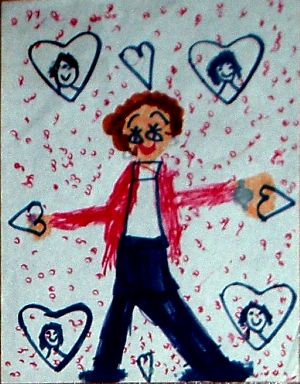
During the early elementary school years, children spend time refining and expanding on creative art skills and interests learned earlier. Understanding the artistic development of school-age children will help child care providers plan art activities that are appropriate for their developing skills. Here are some characteristics of art in 6 to 8 year olds.
-
 Additional details appear. Around the age of 6, many children begin to add those details they left off earlier—fingers, necks, clothing. Children also may begin to tell stories through their work, such as, “I was outside jumping rope when a fire engine drove by.”
Additional details appear. Around the age of 6, many children begin to add those details they left off earlier—fingers, necks, clothing. Children also may begin to tell stories through their work, such as, “I was outside jumping rope when a fire engine drove by.” - Organization becomes evident. Rather than drawing items all over the page, children will line them up across the bottom of the page. They may even draw a baseline or ground line across the page and stand people and other objects on that line.
- Drawing may be repetitive. As children become more skilled artists, they begin to develop their own repertoire of objects, such as trees, flowers, teddy bears and cars. School-age children may practice drawing these same objects again and again, with some deviations and changes. For example, one little girl started drawing balloons, and then every picture had balloons. Sometimes a group of children all start drawing the same thing, such as rainbows or spaceships or dinosaurs.
- Children may discover the relationship between items and color. Realistic colors begin to appear in some drawings. Grass may be green, the family car blue, and the dog brown. The use of these realistic colors represents children’s attempts to put some sort of order in their environment. If children know grass will always be green and not red, then they can put color choices out of their minds and concentrate on other matters.
- Children may be more self-critical. School-age children begin to be interested in drawing realistically and often have a clear picture in their mind’s eye. When they cannot make their drawing look like the picture, they may be critical of their work. School-age children are also more concerned than younger children about how others view their artwork.
To learn more about children’s art, check out our other articles on Art in Child Care, or visit our Child Care Activities and Curriculum section for information on other activities for young children.
